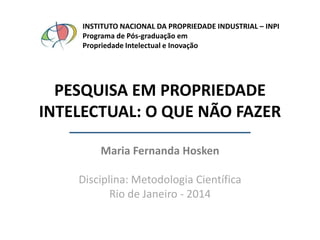Pesquisa em Propriedade Intelectual: o que não fazer
•Télécharger en tant que PPSX, PDF•
0 j'aime•510 vues
O documento fornece 10 dicas para evitar erros comuns em pesquisas acadêmicas em propriedade intelectual. As dicas incluem contextualizar citações, fornecer referências adequadas, corrigir conclusões anteriores divergentes, buscar originalidade e não deixar o leitor sem direção ao fazer comparações. O documento também recomenda ser neutro ou avisar sobre parcialidade, incluir apenas referências históricas pertinentes, ser honesto sobre limitações e revisar o trabalho final para garantir coerência.
Signaler
Partager
Signaler
Partager

Recommandé
Contenu connexe
En vedette
En vedette (20)
Product Design Trends in 2024 | Teenage Engineerings

Product Design Trends in 2024 | Teenage Engineerings
How Race, Age and Gender Shape Attitudes Towards Mental Health

How Race, Age and Gender Shape Attitudes Towards Mental Health
AI Trends in Creative Operations 2024 by Artwork Flow.pdf

AI Trends in Creative Operations 2024 by Artwork Flow.pdf
Content Methodology: A Best Practices Report (Webinar)

Content Methodology: A Best Practices Report (Webinar)
How to Prepare For a Successful Job Search for 2024

How to Prepare For a Successful Job Search for 2024
Social Media Marketing Trends 2024 // The Global Indie Insights

Social Media Marketing Trends 2024 // The Global Indie Insights
Trends In Paid Search: Navigating The Digital Landscape In 2024

Trends In Paid Search: Navigating The Digital Landscape In 2024
5 Public speaking tips from TED - Visualized summary

5 Public speaking tips from TED - Visualized summary
Google's Just Not That Into You: Understanding Core Updates & Search Intent

Google's Just Not That Into You: Understanding Core Updates & Search Intent
The six step guide to practical project management

The six step guide to practical project management
Beginners Guide to TikTok for Search - Rachel Pearson - We are Tilt __ Bright...

Beginners Guide to TikTok for Search - Rachel Pearson - We are Tilt __ Bright...
Pesquisa em Propriedade Intelectual: o que não fazer
- 1. INSTITUTO NACIONAL DA PROPRIEDADE INDUSTRIAL – INPI Programa de Pós-graduação em Propriedade Intelectual e Inovação PESQUISA EM PROPRIEDADE INTELECTUAL: O QUE NÃO FAZER Maria Fernanda Hosken Disciplina: Metodologia Científica Rio de Janeiro - 2014
- 2. .: Texto base • “I Wouldn’t Want to Be Starting from Here” or Why Isn’t Intellectual Property Research Better Than It Is? Prof. Jeremy John Phillips britânico, acadêmico, escritor e consultor em direito da propriedade intelectual. [2009] W.I.P.O.]. No. 1 © 2009 THOMSON REUTERS (LEGAL) LTD. AND CONTRIBUTORS
- 3. I. CITAR FRASES DE AUTORES SEM O DEVIDO CONTEXTO Segundo Lessig... Segundo Phillips... RISCO Desvirtuar a intenção original do autor
- 4. II. PRESUMIR QUE O LEITOR LEU O QUE VOCÊ LEU Senso comum X Referências adequadas
- 5. III. JAMAIS CONTRARIAR CONCLUSÃO ANTERIOR DIVERSA Analisar Essência da pesquisa acadêmica Identificar Explicar “VERDADE”
- 6. IV. CONFUNDIR PESQUISA E ANÁLISE Inovar X Publicar primeiro uma conclusão QUAL A DIFERENÇA?
- 7. V. DEIXAR O LEITOR ÀS SUAS PRÓPRIAS CONCLUSÕES Ao fazer comparações, o leitor deve saber em que direção está sendo levado.
- 8. VI. SER PARCIAL INFORMAÇÃO AO LEITOR - VALORES -
- 9. VII. ADICIONAR REFERÊNCIAS HISTÓRICAS IRRELEVANTES Digressões inúteis
- 10. VIII. NÃO FAZER RESSALVAS Disclaimers: dão ao leitor a exata medida do que se deseja apresentar.
- 11. IX. ESCREVER TEXTOS LONGOS E PROLIXOS Concisão Poder de síntese Clareza “Mais é menos”
- 12. X. NÃO REVISAR O TRABALHO FINAL Início Início MEIO Fim
- 13. O QUE FAZER? 1. 2. 3. 4. 5. Contextualize as citações. Insira as referências adequadamente. Persiga a verdade e saiba corrigir conclusões anteriores divergentes. Busque a originalidade. Não deixe o leitor à deriva diante das comparações feitas.
- 14. O QUE FAZER? (cont.) 6. Tente ser o mais neutro possível. Mas se não for possível, avise ao leitor sobre isso. 7. Adicione referências históricas quando pertinentes, e evite as inúteis. 8. Seja honesto quanto às responsabilidades. 9. Seja o mais claro e conciso possível. 10. Revise o trabalho ao final e veja se é congruente com o ponto de partida.
- 15. .: FIM :. Obrigada! :)
